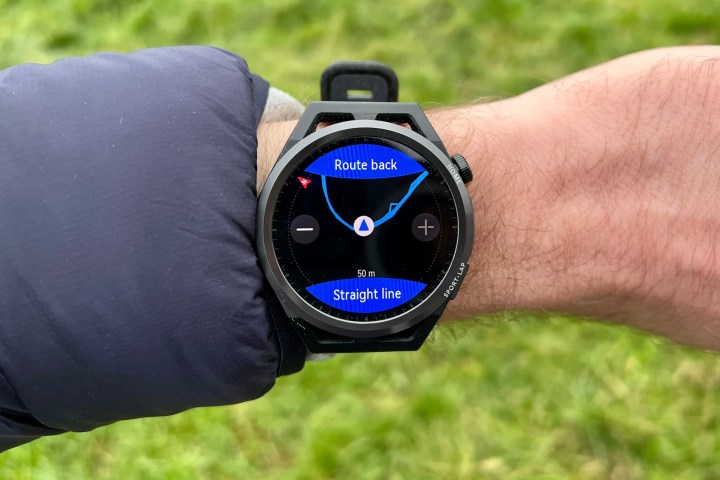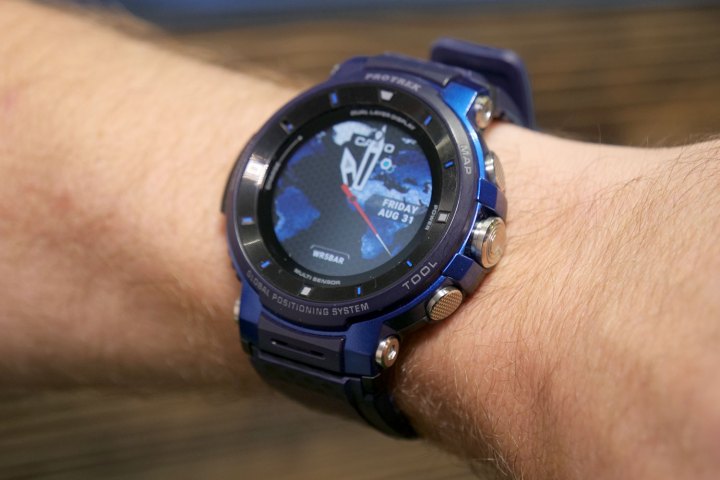Rugged smartwatches are going to become a mainstream thing, and you can thank Samsung and Apple for it. I put Samsung’s name ahead of Apple’s because, technically, Samsung released a somewhat rugged smartwatch before Apple during this latest period of interest in the niche — but the Galaxy Watch 5 Pro is a very different beast from the Apple Watch Ultra. However, together they will encourage other companies to add a tougher model to their own range of smartwatches. Get ready, because many more tough smartwatches are coming.
Two different directions
The Galaxy Watch 5 Pro was initially marketed as a rugged smartwatch for adventurers, with Samsung pushing the Route Back feature, the titanium and sapphire crystal construction, the bigger battery, and the raised bezel as reasons for outdoorsy types to buy the smartwatch. Despite this marketing push, the Watch 5 Pro doesn’t really feel, look, or perform like a rugged smartwatch. It’s more like a posh version of the Galaxy Watch 5 with extended battery life.

If we think about the Galaxy Watch 5 Pro cynically, then the message of it being an outdoor smartwatch could be seen as a last-minute pivot by the marketing team to ensure it could compete with the impending arrival of the Apple Watch Ultra. Once the Watch Ultra did arrive, though, there was no hope of the Watch 5 Pro being a true alternative. Apple has gone all-out to make the Watch Ultra a Garmin competitor, leaving the relatively ordinary spec list of the Watch 5 Pro behind in the swirling desert dust.
I’ve worn them both for a few weeks, and they couldn’t be more different. Leave Samsung’s heavy-handed early marketing behind, and the Watch 5 Pro is a slightly tougher version of the Galaxy Watch 5 with excellent battery life. That’s fine, but no one looking at a Garmin smartwatch would consider it. It’s not even for the weekend warrior who climbs or hikes on a Saturday. It’s more for the monthly warrior, where it’s worn normally almost all the time, with the battery only stretched on a lovely long hike when the weather is good.

The person who buys the Apple Watch Ultra wouldn’t be satisfied with the Galaxy Watch 5 Pro’s functionality. It wouldn’t keep up with their lifestyle, offer the features they wanted, or be able to hold its own against the Garmin or Suunto watch on their friend’s wrist. What’s interesting about the Apple Watch Ultra, though is it also works as an everyday accessory when you’re not pushing any limits. The Galaxy Watch 5 Pro doesn’t really have this versatility.
One single destination
Although they will appeal to different people, the double impact of the Galaxy Watch 5 Pro and the Apple Watch Ultra will mean more people will suddenly be paying attention to rugged smartwatches — perhaps for the first time ever. Previously, getting a smartwatch designed for outdoor pursuits meant going to Garmin, Suunto, Polar, or Coros. Each brand has its own specialty, making products that are extremely focused and competent. But what they aren’t is very attractive, and the brand names lack wide appeal despite many of the features being relevant to a surprisingly wide range of people.

This is where Apple and Samsung have struck gold. Both have started to legitimize rugged smartwatches for the masses. No longer are they only for sweaty runners, Lycra-clad cyclists, or wax jacket-wearing hikers who don’t mind a whopping smartwatch on their wrist that they take off when they get back home. Now they are lifestyle products from brands who make some of the most desirable mobile devices on the planet, and it’s the kind of move that can change an industry.
Until now, a few mainstream manufacturers have released tepid activity smartwatches as secondary products, and often based on existing models, as a way to explore new markets. Huawei based the Watch GT Runner on the Watch GT 3, and pitched it as a multisport smartwatch with highly precise GPS and a route back feature. Amazfit’s T-Rex Pro smartwatch mostly copied the features from the GTR model range, then wrapped it all up in a Casio G-Shock-like body.

It was really Casio that found the most success when trying to make an outdoors smartwatch with the Pro Trek WSD-F30. It combined all of the Pro Trek range’s familiar design elements with an on-point activity app that tracked everything from fishing to trekking. The company also struck key partnerships with other brands. It even had a clever two-screen system to help maximize the battery life. It was really the precursor to the Apple Watch Ultra. While I thought the WSD-F30 was excellent, it was still quite niche and didn’t manage to change the industry. But that’s what Apple and Samsung are about to do.
Rugged smartwatches for everyone, from every company
Apple and Samsung are mobile trendsetters. The list of industry trends that have come from these two is extensive, with everything from folding smartphones to notches becoming talking points due to their products. Neither have always been the first, but they usually make features as approachable and mainstream as possible — and explain them in an understandable way. It creates the ideal opportunity for others to follow along, and this is exactly what’s going to happen with rugged smartwatches.

Today we’re talking about rugged smartwatches in a way that hasn’t really happened before, including whether non-adventurous types can wear them without looking a bit silly. Whether by design or not, the Galaxy Watch 5 Pro and the Apple Watch Ultra appeal to different groups of people in a way that Garmin and its peers have previously been unable or unwilling to explore.
By starting the conversation, Apple and Samsung are opening the doors for other brands to jump on board without having to educate people about the benefits first. It’s the ideal time for brands like Oppo, OnePlus, Xiaomi, Motorola, and HMD Global to brainstorm competing rugged smartwatches, without having to dedicate a massive chunk of the marketing budget to telling us why we may want to wear one.
These brands and many others all offer excellent alternatives to Samsung and Apple’s top mobile products — so why not capitalize on the current buzz around rugged smartwatches too? An influx of competing smartwatches that are tougher and more focused on outdoors seems inevitable if the way Samsung and Apple can regularly move the smartphone world is anything to go by. If Garmin and its peers don’t also take advantage of this wider understanding of their specialties, it’ll be a terrible missed opportunity.
Make no mistake, the double whammy of the Samsung Galaxy Watch 5 Pro and the Apple Watch Ultra has all the potential to see a big, industrywide push into getting us all to consider and wear tougher smartwatches.


